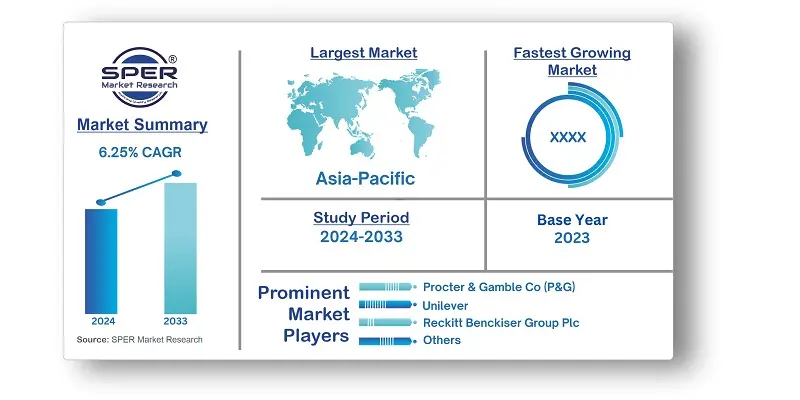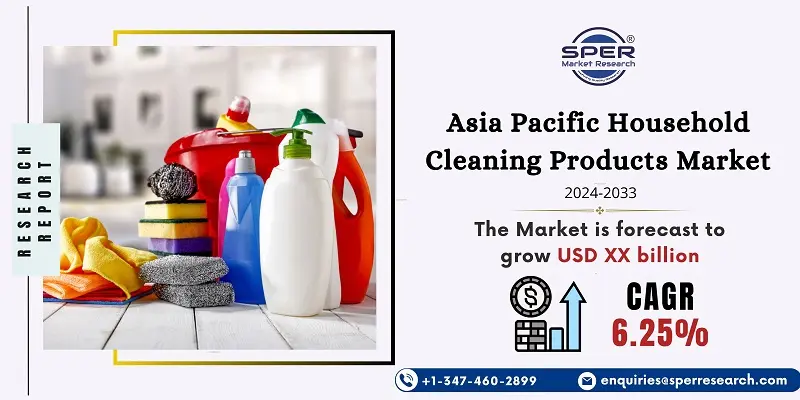
Asia Pacific Household Cleaning Products Market Growth, Size, Trends, Share and Future Outlook
Asia Pacific Household Cleaning Products Market Size- By Product Type, By Distribution Channel, By Application- Regional Outlook, Competitive Strategies and Segment Forecast to 2033
| Published: Sep-2024 | Report ID: FMCG24157 | Pages: 1 - 156 | Formats*: |
| Category : Consumer & Retail | |||
- In January 2023, Henkel and Shell Chemical LP announced a collaboration to replace 200,000 tonnes of crude oil-based feedstock used in surfactant manufacturing with renewable raw materials. Henkel plans to employ these renewable surfactants in their laundry product lines. The action is estimated to cut greenhouse gas emissions by up to 120,000 tonnes during the five-year agreement period.
- In March 2022, Henkel and BASF announced a collaboration to replace fossil-based feedstock with renewable feedstock for laundry and homecare products. The agreement is intended to replace 110,000 tonnes of fossil-based feedstock in Henkel cleaning products each year. The move is expected to lower carbon footprint by eliminating 200,000 tonnes of CO2 emissions.


| Report Metric | Details |
| Market size available for years | 2020-2033 |
| Base year considered | 2023 |
| Forecast period | 2024-2033 |
| Segments covered | By Product Type, By Distribution Channel, By Application. |
| Regions covered | China, Japan, India, South Korea, Australia, Indonesia, Others. |
| Companies Covered | Procter & Gamble Co, Godrej Consumer Products Limited, Kao Corporation, The clorox company india Private Limited, Reckitt Benckiser Group Plc, Colgate-Palmolive(International), Lion Corporation, S. C. Johnson & Son, Inc, McBride plc, Bolton Group Srl, Henkel AG & Company, KGaA, Unilever. |
- Residential consumers
- Hotels and hospitality businesses
- Commercial establishments
- Healthcare facilities
- Retail stores and supermarkets
- E-commerce platforms
- Cleaning service providers
- Government and public institutions
| By Product Type: |
|
| By Distribution Channel: |
|
| By Application: |
|
- Asia Pacific Household Cleaning Products Market Size (FY’2024-FY’2033)
- Overview of Asia Pacific Household Cleaning Products Market
- Segmentation of Asia Pacific Household Cleaning Products Market By Product Type (Surface Cleaners, Specialty Cleaners, Bleaches)
- Segmentation of Asia Pacific Household Cleaning Products Market By Distribution Channel (Supermarkets/Hypermarkets, Convenience Stores, Online Retail Stores, Others)
- Segmentation of Asia Pacific Household Cleaning Products Market By Application (Bathroom Cleaners, Kitchen Cleaners, Floor Cleaners, Fabric Care, Others)
- Statistical Snap of Asia Pacific Household Cleaning Products Market
- Expansion Analysis of Asia Pacific Household Cleaning Products Market
- Problems and Obstacles in Asia Pacific Household Cleaning Products Market
- Competitive Landscape in the Asia Pacific Household Cleaning Products Market
- Impact of COVID-19 and Demonetization on Asia Pacific Household Cleaning Products Market
- Details on Current Investment in Asia Pacific Household Cleaning Products Market
- Competitive Analysis of Asia Pacific Household Cleaning Products Market
- Prominent Players in the Asia Pacific Household Cleaning Products Market
- SWOT Analysis of Asia Pacific Household Cleaning Products Market
- Asia Pacific Household Cleaning Products Market Future Outlook and Projections (FY’2024-FY’2033)
- Recommendations from Analyst
1.1. Scope of the report1.2. Market segment analysis
2.1. Research data source
2.1.1. Secondary Data2.1.2. Primary Data2.1.3. SPER’s internal database2.1.4. Premium insight from KOL’s
2.2. Market size estimation
2.2.1. Top-down and Bottom-up approach
2.3. Data triangulation
4.1. Driver, Restraint, Opportunity and Challenges analysis
4.1.1. Drivers4.1.2. Restraints4.1.3. Opportunities4.1.4. Challenges
4.2. COVID-19 Impacts of the Asia Pacific Household Cleaning Products Market
5.1. SWOT Analysis
5.1.1. Strengths5.1.2. Weaknesses5.1.3. Opportunities5.1.4. Threats
5.2. PESTEL Analysis
5.2.1. Political Landscape5.2.2. Economic Landscape5.2.3. Social Landscape5.2.4. Technological Landscape5.2.5. Environmental Landscape5.2.6. Legal Landscape
5.3. PORTER’s Five Forces
5.3.1. Bargaining power of suppliers5.3.2. Bargaining power of buyers5.3.3. Threat of Substitute5.3.4. Threat of new entrant5.3.5. Competitive rivalry
5.4. Heat Map Analysis
6.1. Asia Pacific Household Cleaning Products Market Manufacturing Base Distribution, Sales Area, Product Type6.2. Mergers & Acquisitions, Partnerships, Product Launch, and Collaboration in Asia Pacific Household Cleaning Products Market
7.1. Asia Pacific Household Cleaning Products Market Size, Share and Forecast, By Product Type, 2020-20267.2. Asia Pacific Household Cleaning Products Market Size, Share and Forecast, By Product Type, 2027-20337.3. Surface Cleaners7.4. Specialty Cleaners7.5. Bleaches
8.1. Asia Pacific Household Cleaning Products Market Size, Share and Forecast, By Distribution Channel, 2020-20268.2. Asia Pacific Household Cleaning Products Market Size, Share and Forecast, By Distribution Channel, 2027-20338.3. Supermarkets/Hypermarkets8.4. Convenience Stores8.5. Online Retail Stores8.6. Others
9.1. Asia Pacific Household Cleaning Products Market Size, Share and Forecast, By Application, 2020-20269.2. Asia Pacific Household Cleaning Products Market Size, Share and Forecast, By Application, 2027-20339.3. Bathroom Cleaners9.4. Kitchen Cleaners9.5. Floor Cleaners9.6. Fabric Care9.7. Others
10.1. Asia Pacific Household Cleaning Products Market Size and Market Share
11.1. Asia Pacific Household Cleaning Products Market Size and Market Share By Region (2020-2026)11.2. Asia Pacific Household Cleaning Products Market Size and Market Share By Region (2027-2033)11.3. China11.4. Japan11.5. India11.6. South Korea11.7. Australia11.8. Indonesia11.9. Others
12.1. Procter & Gamble Co
12.1.1. Company details12.1.2. Financial outlook12.1.3. Product summary12.1.4. Recent developments
12.2. Godrej Consumer Products Limited
12.2.1. Company details12.2.2. Financial outlook12.2.3. Product summary12.2.4. Recent developments
12.3. Kao Corporation
12.3.1. Company details12.3.2. Financial outlook12.3.3. Product summary12.3.4. Recent developments
12.4. The clorox company india Private Limited
12.4.1. Company details12.4.2. Financial outlook12.4.3. Product summary12.4.4. Recent developments
12.5. Reckitt Benckiser Group Plc
12.5.1. Company details12.5.2. Financial outlook12.5.3. Product summary12.5.4. Recent developments
12.6. Colgate-Palmolive (International)
12.6.1. Company details12.6.2. Financial outlook12.6.3. Product summary12.6.4. Recent developments
12.7. Lion Corporation
12.7.1. Company details12.7.2. Financial outlook12.7.3. Product summary12.7.4. Recent developments
12.8. S. C. Johnson & Son, Inc
12.8.1. Company details12.8.2. Financial outlook12.8.3. Product summary12.8.4. Recent developments
12.9. McBride plc
12.9.1. Company details12.9.2. Financial outlook12.9.3. Product summary12.9.4. Recent developments
12.10. Bolton Group Srl
12.10.1. Company details12.10.2. Financial outlook12.10.3. Product summary12.10.4. Recent developments
12.11. Henkel AG & Company, KGaA
12.11.1. Company details12.11.2. Financial outlook12.11.3. Product summary12.11.4. Recent developments
12.12. Unilever
12.12.1. Company details12.12.2. Financial outlook12.12.3. Product summary12.12.4. Recent developments
12.13. Others
SPER Market Research’s methodology uses great emphasis on primary research to ensure that the market intelligence insights are up to date, reliable and accurate. Primary interviews are done with players involved in each phase of a supply chain to analyze the market forecasting. The secondary research method is used to help you fully understand how the future markets and the spending patterns look likes.
The report is based on in-depth qualitative and quantitative analysis of the Product Market. The quantitative analysis involves the application of various projection and sampling techniques. The qualitative analysis involves primary interviews, surveys, and vendor briefings. The data gathered as a result of these processes are validated through experts opinion. Our research methodology entails an ideal mixture of primary and secondary initiatives.



Frequently Asked Questions About This Report
PLACE AN ORDER
Year End Discount
Sample Report
Pre-Purchase Inquiry
NEED CUSTOMIZATION?
Request CustomizationCALL OR EMAIL US
100% Secure Payment






Related Reports
Our Global Clients
Our data-driven insights have influenced the strategy of 200+ reputed companies across the globe.




















